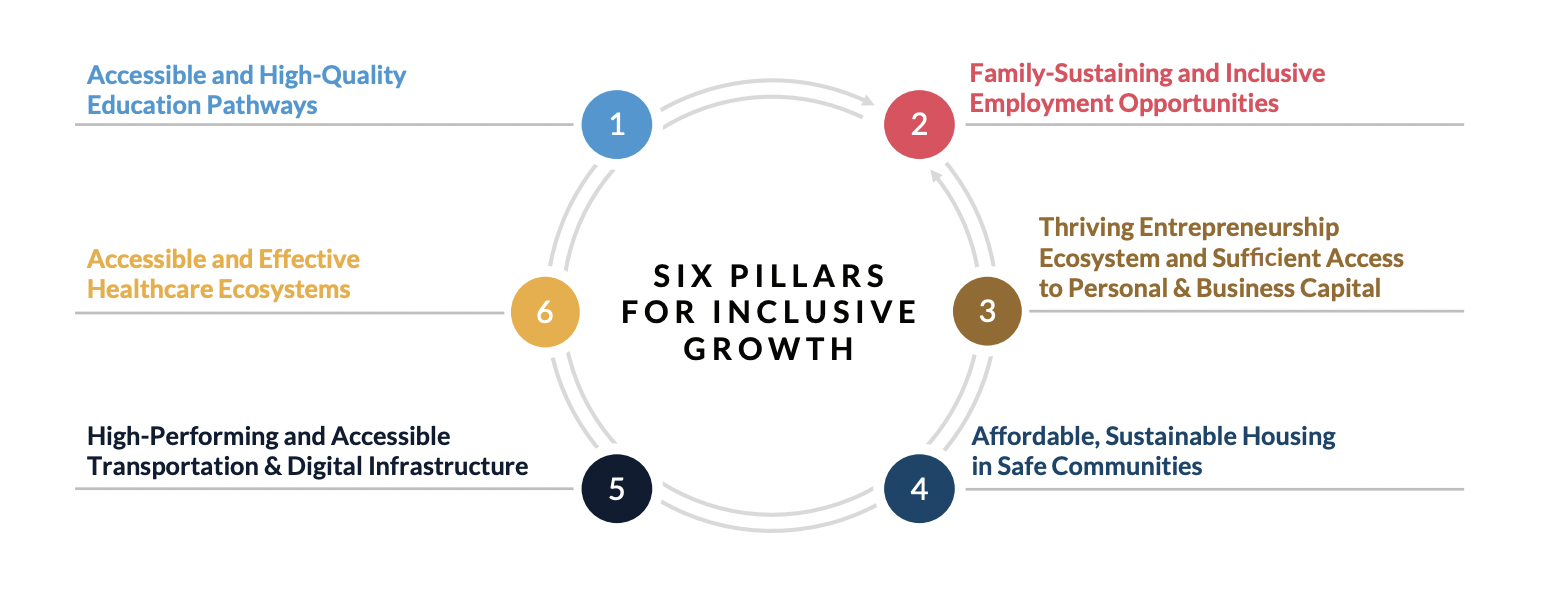We sat down with Francesca Ioffreda, the Partnership’s VP for Inclusive Growth & Talent Initiatives, and Kwasi Mitchell, Chief Purpose Officer at Deloitte, to share their views on the future of the region and the foundation needed to foster equity.
Francesca, before we dive in, can you share a quick overview of what inclusive growth means for the region, who the Inclusive Growth Strategy Council is, and what the Inclusive Growth Blueprint is?
As a Capital Region native, it’s incredibly exciting to be part of an organization that is committed to advancing regional shared prosperity where all residents can thrive irrespective of their race or zip code. Growing up here, I was always drawn to the area’s rich cultural fabric, diversity, dynamism, and history, and I think it’s important that we maintain and build on these strengths.
Last year, we commissioned research that highlighted the inextricable link between inclusive growth and improved economic outcomes. One of the biggest discoveries was that driving more equitable prosperity in the Capital Region alone has the potential to unlock $35-50 billion in GDP by 2028. The Partnership is committed to Inclusive Growth, recognizing it as the moral and economic imperative of our time.
The Inclusive Growth Strategy Council is a coalition of business leaders and organizations dedicated to thinking strategically about the long-term inclusive growth needs of the region and driving change today. Co-chaired by Jason Wright (Washington Football Team) and Sheila Johnson (Salamander Hotels & Resorts), the Council has defined inclusive growth as economic growth that creates a prosperous, equitable, and resilient society for people of all backgrounds and incomes, particularly for those facing the greatest barriers, by broadly expanding economic opportunity and enhancing quality of life across the Capital Region.
The Preface Report is a precursor to the forthcoming Blueprint which will be published in mid-2022. With input from community, public, and private sector stakeholders, the Blueprint outlines six pillars for inclusive growth: Accessible & High-Quality Education Pathways; Family-Sustaining & Inclusive Employment Opportunities; Thriving Entrepreneurship Ecosystem & Access to Capital; Affordable, Sustainable Housing in Safe Communities: High-Performing & Accessible Transportation & Digital Infrastructure; and Accessible & Effective Healthcare Ecosystems (Figure 1). The Blueprint will provide a roadmap to make the Capital Region from Baltimore to Richmond the most inclusive economy in the nation within 10 years by amplifying existing efforts in the region, identifying further potential for cross-sector collaboration, and highlighting opportunities to catalyze solutions at scale. It will focus on actions where the business community is best equipped to lean in and foster cross-sector partnerships to drive inclusive growth.
 (Figure 1) Inclusive Growth Blueprint Pillars
(Figure 1) Inclusive Growth Blueprint Pillars
Kwasi, as a leader in the region, what excites you about getting involved with the Partnership’s inclusive growth efforts? How does the rollout fit your organization and its strategy?
I’ve been in the Greater Washington Area for over 20 years, alongside many of our clients and professionals that live and work here as well. So, seeing businesses come together to drive more inclusive growth is pretty remarkable. I believe the corporate sector has a crucial role to play in creating an inclusive economy because our spheres of influence are so considerable. For starters, we have a direct impact on our workplaces, on the people we hire, the ways we develop them and their experiences. We also have influence in our communities in terms of how we invest and what we support. So, the more companies in our region can come together in an organized and effective way, the more we achieve scale when it comes to equitable growth.
And as you indicate, this is all a great fit for Deloitte, because we are striving for our business strategy and our purpose strategy to be one in the same. Let’s face it – we are a large and matrixed organization. Our challenge is taking a concept like purpose and cascading it throughout our organization, so that it not only reflects our vision but also governs what each of us do on a daily basis as we go about our jobs and interact with each other. How do you make purpose ubiquitous?
Then there’s the external dimension. How do we invest differently in our communities, build coalitions, and engage cross-sector stakeholders to truly identify and address the root causes of inequity and foster an economic system where everyone can thrive?
We are so grateful to be collaborating with the Partnership because it’s creating pathways and support for us to achieve our internal and external goals when it comes to strategy and purpose. And, more importantly, the Inclusive Growth Blueprint is an opportunity to multiply this impact by engaging an ecosystem of diverse companies and organizations across the region.
Building off those great insights from Kwasi, Francesca, can you zoom out a bit and share about the framework and approach the IGSC is using to build the Inclusive Growth Blueprint?
At its core, the Council recognizes that driving inclusive growth requires a collaborative strategy: government, community, and private sector stakeholders each have a unique role to play in advancing solutions that promote broad participation and inclusive economic opportunity. As someone who has worked in each of these sectors throughout my career, I think we can unlock real value when we bring each of these perspectives together.
Advancing inclusive growth also requires a holistic approach. We know that issues can’t be solved in silos, and that all challenges are interconnected. For example, providing an individual with access to higher education will not enable them to thrive if they do not have stable housing, good health, reliable transportation, and financial wealth to sustain themselves and their family.
The goal of the Blueprint is to identify specific actions that stakeholders from each sector can lead – which is why we’ve engaged a diverse range of public, private, and non-profit actors through interviews and task forces. We believe inclusivity is as important in the process as in the outcome, so we will continue to engage community members more broadly throughout the Blueprint’s development and implementation. Once we finalize the actions, we will start to identify metrics to track progress towards achieving inclusive growth.
Kwasi, any thoughts to add there?
I wholeheartedly agree with Francesca and, in fact, this idea of taking a holistic approach is a key reason we are thrilled to be involved. Many of the barriers to economic opportunity are so large that they can’t be solved by a single actor or by money alone.
Through our work with the Partnership over these last few months, we’ve had the opportunity to engage employers, leaders in the social sector and philanthropy, educational institutions, researchers and think tanks, policy makers – the list goes on. I’ve been inspired by conversations and ideas that have surfaced, and it’s further highlighted the importance of engaging community members to develop solutions that are tailored to their community’s needs. To identify and shape solutions and actions that companies can collectively take to address systemic racism and discrimination and expand economic opportunity, particularly for those that face the greatest barriers, we must work together.
Additionally, to be effective collaborators, it is key for businesses to focus internally on integrating purpose and inclusive practices into core business strategies and operations, versus having it as a separate silo within the organization. Purpose should be more than a company’s corporate social responsibility initiative. It should be directly tied to economic performance, competitive advantage, and long-term value creation.
An essential feature of the Inclusive Growth Strategy Council is having leaders that are committed to both internal change and external societal impact. Francesca, can you speak to Kwasi’s point on aligning purpose to business strategy and what it means for your work?
I think that Kwasi hit the nail on the head. Aligning purpose to business is central to why leaders choose to engage in the work of the Inclusive Growth Strategy Council.
The leaders who sit on the Council are focused on doing the work to ensure purpose is ingrained in their business priorities. These leaders are engaged in efforts to foster diversity and create inclusive workplaces within their organizations and the Blueprint will provide a further guide of how they can address these issues.
Many members are engaged in efforts to diversify their supply chain by procuring products and services from minority-owned business enterprises (MBEs). There are clear business and purpose goals to this: one, a diverse supplier pipeline is more sustainable and resilient to economic shifts. We’re seeing this now with the supply chain challenges facing nearly every industry as a result of the COVID-19 crisis. Second, purchasing from more MBEs is an impactful way to support and invest in minority communities – spending more money with minority owned businesses further allows them to grow and scale, which builds a more inclusive and diverse economy all around.
However, we know the work is ongoing, and that the transformation cannot happen overnight. Our work at the Partnership is not only to help identify a vision and strategy for advancing equitable economic solutions and closing the racial wealth gap in the Capital Region, but also to provide the consistent, long-term support and thought partnership to our partners as they continue to explore opportunities to better align their business and purpose goals.
Kwasi, please share more with us about what companies – and especially their leaders – can do to advance inclusive growth. And then, wrap us up with some closing thoughts.
Three thoughts here. One, understand your strengths. Identify two or three areas where you are uniquely positioned to contribute and then work alongside others within the community who complement those strengths so that together, you can multiply your collective impact.
Second, pick your priorities. There are so many challenges that are vying for our attention. Rather than trying to tackle everything, aligning on a handful of issues that are also core to your business strategy will help you focus your resources and drive more meaningful and sustainable impact.
Third, listen to your employees and lead through your actions. Educating our workforces about diversity, equity, and inclusion is a great first step, but the business community can and needs to do more. As leaders, we are in positions to elevate this conversation and lay the groundwork for all employees, especially for those to access opportunities previously thought beyond their reach.
I mentioned this earlier, but I’ll reiterate it here because I think it’s so important. The challenges and barriers to inclusive growth can’t be addressed by any single organization. It’s a significant undertaking that requires long-term commitment and deliberate collaboration across sectors and jurisdictional boundaries. I believe is it possible. We have a unique opportunity to power transformational change and design a better future for this region.
Thank you both so much for sharing your thoughts today. Francesca, before we wrap, can you share a bit about what you’ve heard from across the region so far, and what comes next in the development of the Inclusive Growth Blueprint?
Yes! We have started to engage a wide range of community stakeholders to refine the solutions, and actions in the Preface report. We are learning from organizations and experts that are already working to solve some of the issues outlined in the Pillars, and we recently set up task forces to better understand community needs, resource constraints, and potential solutions. We’ve heard some great feedback on where the business community can be most supportive of the work already happening on the ground and we are in the process of revising the solutions and actions to reflect that. We look forward to engaging as many voices as possible in this collective effort – please join us in this journey.
Kwasi, I also just want to thank you and Deloitte for leading by example in this region and nationally. Your purpose-driven leadership, early collaboration, and continued engagement has been critical in the development of the Preface Report and charting a path for the development of the Blueprint. We couldn’t do this important work without you!



